Add These Strength Workouts to Your Training Plan to Ride Faster
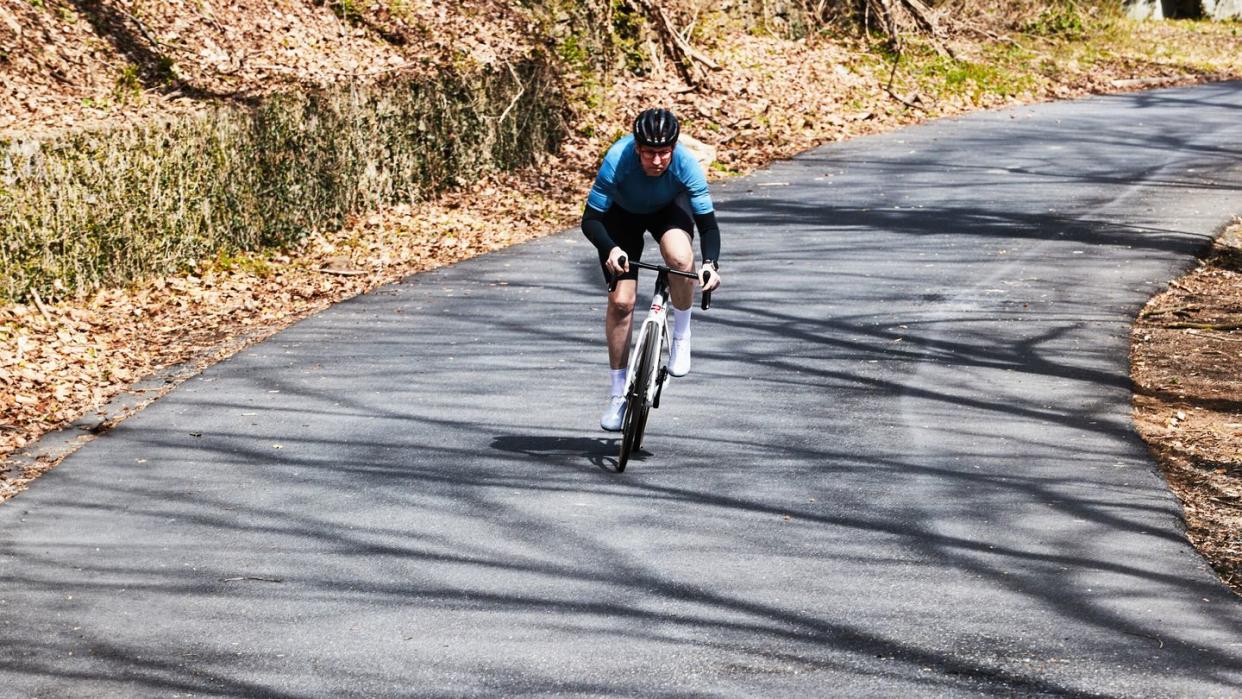
"Hearst Magazines and Yahoo may earn commission or revenue on some items through these links."
If you want to get faster on the bike, the good news is, it’s totally possible. The less-good news: You probably won’t reach your potential by simply adding mileage or intensity. To get the results you want, it’s time to supplement your cycling with strength training.
“Strength training improves your cycling economy and your sprint speed. Plus, strengthening your muscles and connective tissue prevents injury, which means fewer days off and more available days to train,” says Hannah Lally, doctor of physical therapy and strength and conditioning coach.
Not sure how you’re going to make time for strength training? One systematic review found that highly trained cyclists’ performance improved when strength training replaced some of their time in the saddle. Another small study found that of the nine elite cyclists who added two heavy lifting sessions per week to their cycling workouts, they saw better cycling performance than their peers who did the same cycling program minus the weights.
To help you fine-tune your strength workouts to improve your speed on the bike in particular, we talked to Menachem Brodie, C.S.C.S., USA Cycling expert coach, head strength coach for the Israel Cycling Federation Track Program, and author of Strength Training for Cycling Performance, along with Lally, to give you their favorite speed-boosting workouts. Which one suits you best depends on where you are in your training, your goals for that session, and what equipment you have access to.
Strength Workout for Speed #1
Best for... those just starting out with strength training or those who have limited time and equipment
When you’re short on time or equipment but you want to get in a strength workout to supplement your cycling, make this workout your go-to. “This is what I’d give some of my top riders if they were stuck in an airport without access to a gym but needed to get a workout in,” says Brodie.
This is a great session to do in-season, after your ride, so you can optimize your cycling adaptations while still getting the kind of stimulus that’s unique to strength training. Whatever you do, “make sure the focus is on technique,” says Brodie.
How to use this list: Start with two sets of the first exercise as your warmup, then complete two sets of exercises 2-7, following the reps listed below.
1. Crocodile Breathing With Towel
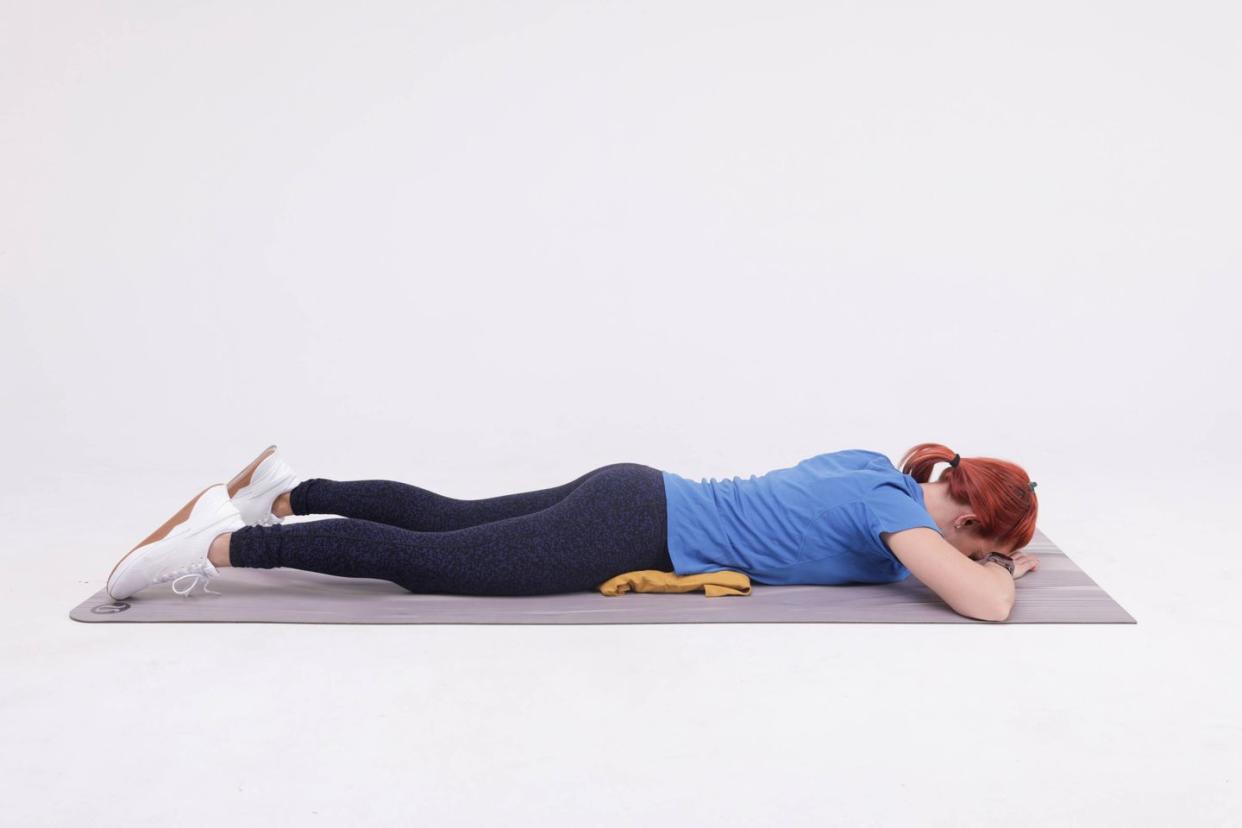
Why it works: Starting your strength workout with this move helps to put you in a more relaxed state (both mentally and physically) before adding intensity to the workout, says Brodie. By mobilizing your lower back and relaxing your shoulders, it also puts you in a better overall posture, which allows you to transfer more power to your pedals.
How to do it:
Lie facedown with a sweatshirt or towel directly underneath ribcage and hips.
Raise arms overhead, bend elbows, place one hand on top of the other, and rest forehead on hands.
Relax shoulders and point feet. This is the holding position.
Take a deep breath in through nose for 5 seconds, feeling lungs expand through mid and lower back.
Hold breath for 2 seconds.
Exhale slowly through mouth for 5 seconds.
Hold the exhale for 2 seconds. Keep shoulders relaxed the entire time.
Perform 2-3 sets of 5-8 breaths with a short rest between sets.
2. McGill Crunch
Why it works: The McGill crunch trains you to connect your rib cage and pelvis to promote a healthier spine, reduce your risk of low back pain, and increase your power on the bike, says Brodie. (If you’re postpartum, and/or are experiencing diastasis recti or prolapse, check with a pelvic floor physical or occupational therapist before you try it.)
How to do it:
Lie faceup with one knee bent and the other straight.
Place hands, palms down, beneath low back. (They serve as a “pressure sensor” to ensure a natural curve in lumbar spine.)
To support neck, gently clench jaw and press tongue into the roof of mouth.
Lift elbows a couple of inches off the floor.
While engaging core and using the base of ribcage as a pivot point, lift head and rib cage just slightly up off the floor. (Imagine head and shoulders are resting on a scale; goal is to make the scale read zero.)
Hold this position for a count of 5.
With control, lower back down.
Rest for 10 seconds and repeat for a total of 5 reps.
3. Side Plank With Top Foot Forward
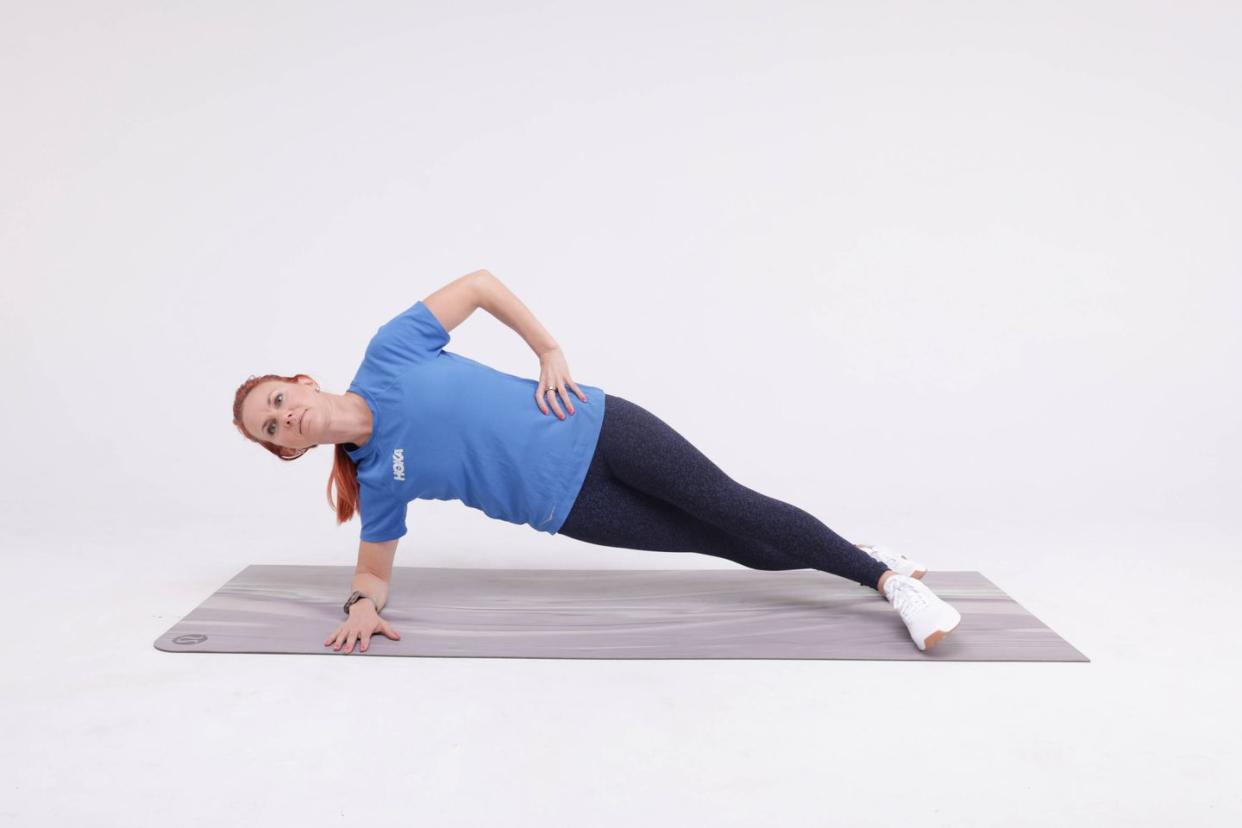
Why it works: This exercise works your core, and promotes shoulder stability, all of which help you transfer power to your pedals more efficiently, says Brodie.
How to do it:
Lie on right side, with knees and hips flexed to about 90 degrees and hand on hip. Head, shoulders, and hips in alignment.
Lift hips off floor and slightly forward.
Straighten top leg and bring foot slightly forward.
Straighten bottom leg and extend it back slightly so back toes are aligned with top heel while keeping hips stacked.
Bring top shoulder back slightly to fully engage core.
Hold for 5-7 seconds.
Come back to the starting position in reverse, bringing bottom knee to the floor, resting the top knee on the bottom knee, and then lowering hips back and down.
Rest for 3-10 seconds.
Repeat for a total of 5 reps.
4. Mini Band Pull-Apart Squat
Why it works: You’re teaching your muscles to create full-body tension while performing a squat, which translates into improved power for climbing and time trialing, along with better bike handling skills, says Brodie.
How to do it:
Stand with feet about shoulder-width apart with the corner of a box, bench, or coffee table just between legs.
With elbows at sides and palms facing each other, loop a light tension mini loop band around wrists and bend elbows.
Maintaining tension on the band while keeping chin tucked, ribcage stacked directly over pelvis, and elbows flexed to about 90 degrees, bring elbows forward and up to shoulder height.
Squat down to touch the corner of box for a count of 2. Maintain tension on the band.
Without pausing at the bottom of squat, drive through feet to stand back up for a count of 2.
Repeat. Do 3- 5 repetitions and work up to 10.
5. Coin Under 3rd Toe Middle Toes Lift
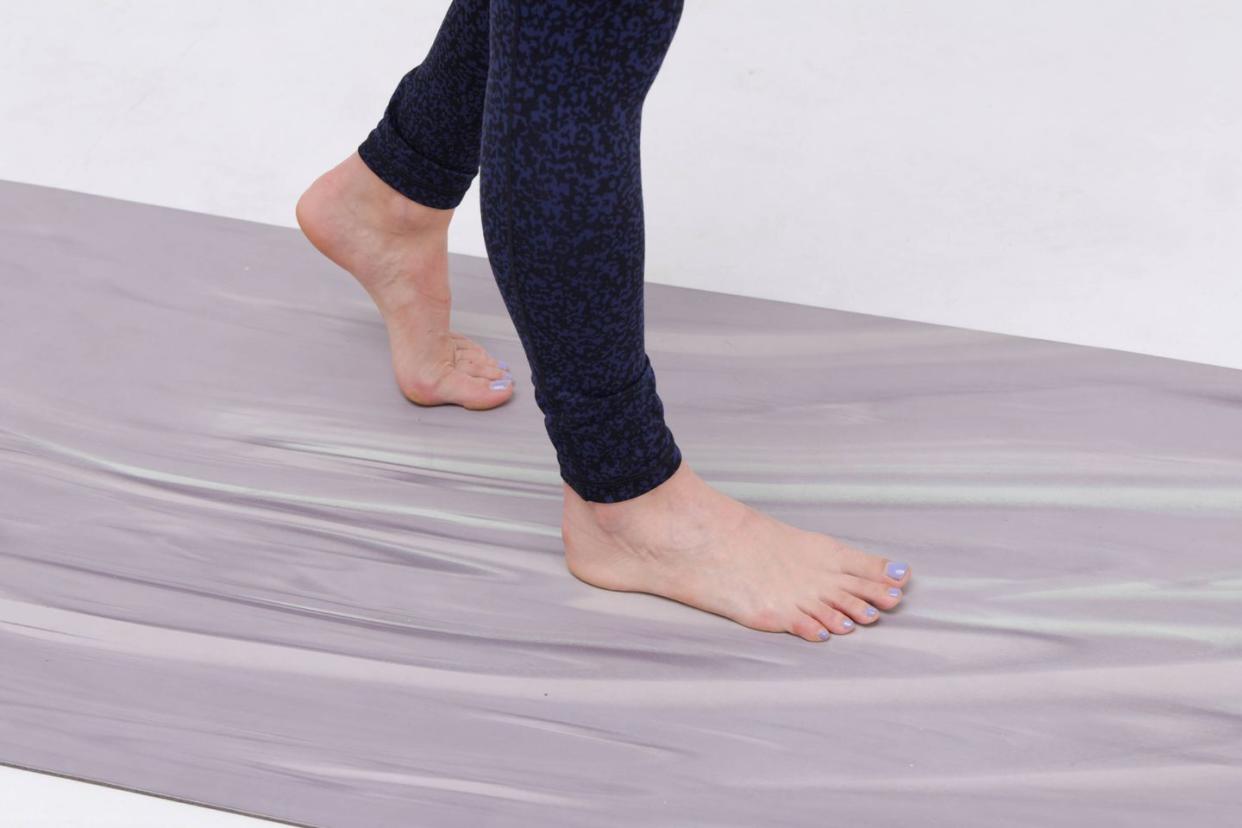
Why it works: This exercise develops your foot’s transverse arch, which is foundational to your cycling. “A strong transverse arch helps you to manage the force you’re putting on your pedals, so there’s less stress up the kinetic chain to the ankle, knee, and hip, which helps with injury prevention and cycling economy,” says Brodie.
How to do it:
Place a coin at the base of third toe. (Don’t skip this step; the coin provides important tactile feedback.)
Raise middle three toes, keeping big and pinky toes on the ground.
Lower them back down with control.
Repeat. Do 10-15 reps.
6. Jump Rope
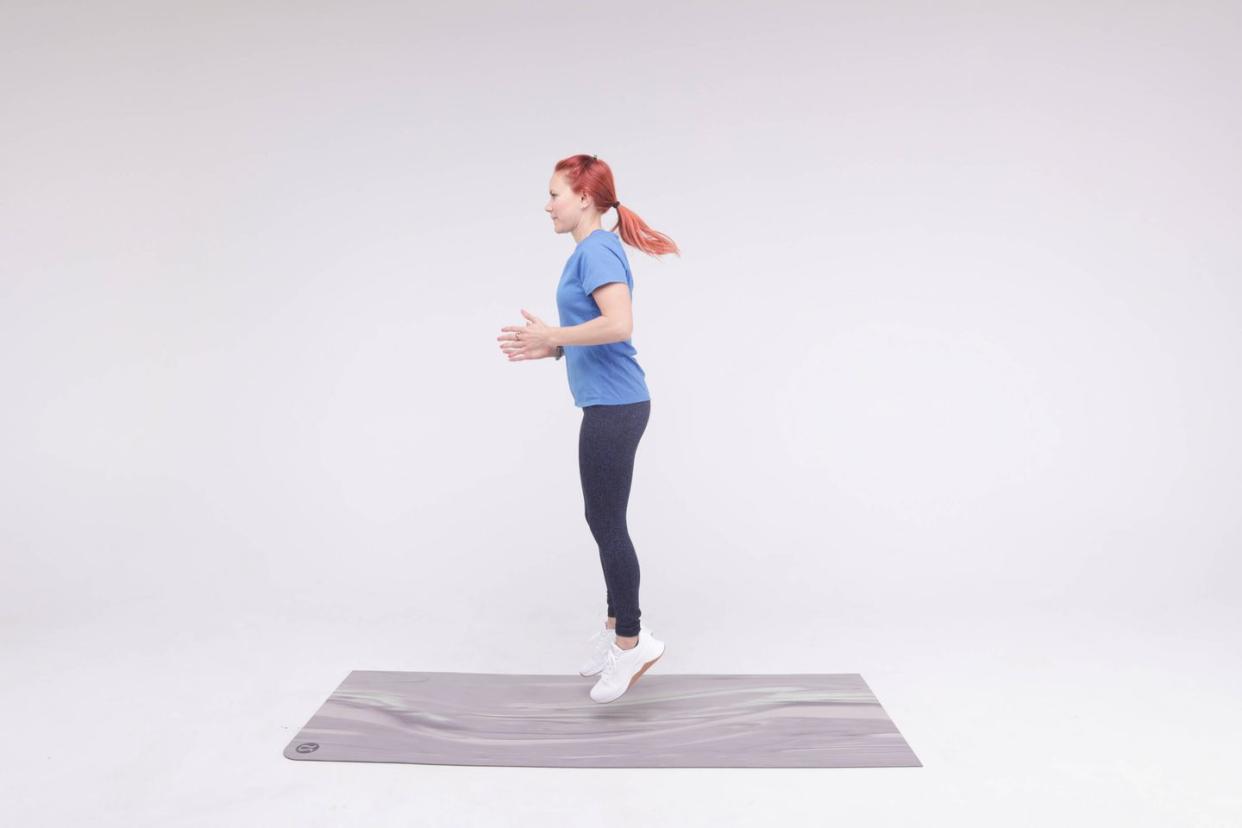
Why it works: Jumping rope (even if you don’t have an actual rope) helps the tissues of your lower legs expand their capacity to handle explosive forces and to hold more energy—which helps you drive power from your hips into your pedals, says Brodie.
How to do it:
Stand with feet together, holding a jump rope in both hands (or pretend to hold one).
Jump lightly and quickly with both feet for 7 seconds.
Rest until you catch your breath. Repeat for at least 3 rounds.
7. Bird Dog
Why it works: This classic core exercise engages your abdominal muscles and glutes. At the same time, by teaching you how to fire the muscles on one side of your body while keeping the others relaxed, it develops your mind-muscle connection, says Brodie.
How to do it:
Get on hands and knees in a tabletop position.
Keeping core engage, extend one arm out in front of while extending the opposite leg back. Make sure to engage shoulder in weight-bearing arm while using only glute muscle to extend opposite leg.
Hold for 10 seconds.
Keeping elbow straight, flex shoulder and opposite hip to bring elbow toward opposite knee.
Repeat. Do 5 reps on each side.
Strength Workout for Speed #2
Best for: those ready to lift heavier with basic knowledge of common exercise form and access to kettlebells and/or dumbbells—or even a barbell
Whether you do this one before or after a ride depends on how well you can execute the workout with good form. “If you’re dialed with your movement patterns, you can do it after a hard ride,” says Lally.
If you’re a resistance training novice or unsure of your form, it’s better to tackle this session before a ride, when your legs are fresh. In any case, you’ll want to avoid this spicy workout on your rest or active recovery days.
How to use this list: This workout features six exercises, which you’ll perform as three supersets. In other words, each superset includes two moves you’ll alternate between for the prescribed number of rounds before moving on to the next superset. Rest as needed between exercises and rounds.
Superset 1: 3-4 rounds
1. Lateral Step-Ups
Why it works: This move activates your lateral hip muscle to help you avoid “leaking” energy laterally and helps improve the efficiency of your pedal stroke, says Lally. You can do this one without weights (and you won’t need any if you go slowly enough), but you can add weight to up the intensity, as long as you maintain solid form.
How to do it:
With body perpendicular to a box or step, step onto it with one leg and let the other leg hang off the side. Keep core engaged.
Slowly lower hips back and down while lowering free heel down toward the ground.
Gently tap heel to the floor.
Repeat. Do 8 reps.
Then switch sides.
2. Forearm Plank
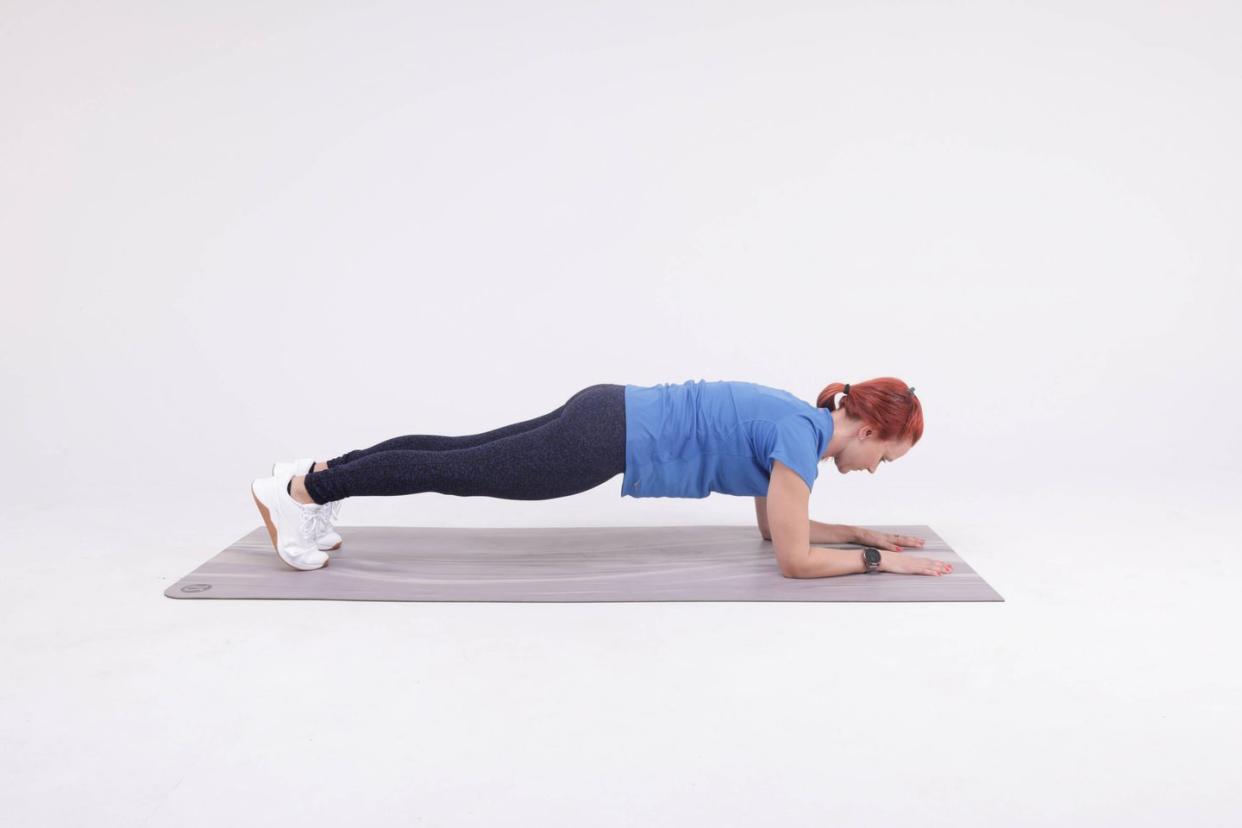
Why it works: Core strength develops your efficiency and your ability to hold your position on the bike, says Lally.
How to do it:
With elbows directly under shoulders and feet hip-width apart, rest weight on forearms and toes.
Keep shoulders and hips in alignment, engage core so that you’re pulling navel toward spine, and energetically drive elbows and feet toward one another to create tension throughout core.
Hold for 1 minute or until form begins to deteriorate. Gradually increase the duration as strength improves.
Superset 2: 4 rounds
3. Squat
Why it works: Squats do an excellent job of engaging the muscles you rely on to power your pedal stroke, says Lally. If you can access a barbell, that’s ideal. “A back squat really engages your glutes, which cyclists need,” she says. But if you only have a kettlebell or dumbbell, that works too. Select a moderately heavy weight. (After completing a set, you should feel like you could only complete about 3 more repetitions with good form.)
How to do it:
With barbell on back or holding weight at chest, stand with feet about shoulder-width apart. “Screw” feet into the floor by activating the adductor muscles in your inner thighs.
With core engaged and without letting knees fall inward, send hips back and down, bending knees until thighs are about parallel to the floor.
Focus on pushing the floor away to stand up, engaging glutes.
Repeat. Do 6 reps.
4. Kettlebell Swing
Why it works: This hip-driven move forces your glutes to work hard for a very short period of time. “By pairing them with squats, you’re training your glutes to keep going when your quads are fatigued, which is perfect for cyclists,” says Lally. Choose the heaviest weight you can handle while maintaining explosiveness throughout the entire set.
How to do it:
Align kettlebell on floor, about an arm’s length away.
Hinge at hips, sending butt straight back, and grab the kettlebell handle with two hands, palms facing down. Tip the kettlebell handle toward you.
Start the swing by hiking the bell between the legs.
Squeeze glutes, drive feet into floor, and aggressively extend hips to allow the kettlebell to pass back through the legs and up to a floating position in front of the body at chest level, with both arms fully extended.
Let gravity bring the bell back down in-between legs as you inhale.
Repeat. Do 12 reps.
Superset 3: 3-4 rounds
5. Bulgarian Split Squats
Why it works: This intense move targets your quads, glutes, and hamstrings, all of which serve as power generators on the bike, says Lally.
How to do it:
Holding a dumbbell in each hand by sides, stand about two to three feet in front of a box or bench with feet about hip-width apart.
Place back foot on the box or bench.
Lower down into a lunge position with the majority of weight in front leg while aligning knee with pinky toe. (Don’t let knee collapse inward.)
Focus on engaging the back of front leg as you drive foot into floor and stand back up.
Repeat. Do 6 reps.
Then switch sides.
If you can do this move with solid form, continue with the plyometric move below:
Release weights and perform the movement as described above.
As you stand back up, forcefully drive through front foot, exploding off floor. Be careful to keep knee aligned with pinky toe.
Repeat. Do 6 reps.
Then switch sides.
6. Renegade Rows
Why it works: Similar to planks, renegade rows are great for core stability and bike handling, says Lally.
How to do it:
Start in plank position, both hands on a dumbbell.
While keeping hips stable, perform a row with each hand, elbow pulling back and weight reaching hip, engaging back muscles.
Lower weight back down to plank position.
Repeat on opposite side.
Continue alternating. Do 6-8 reps per side.
You Might Also Like
